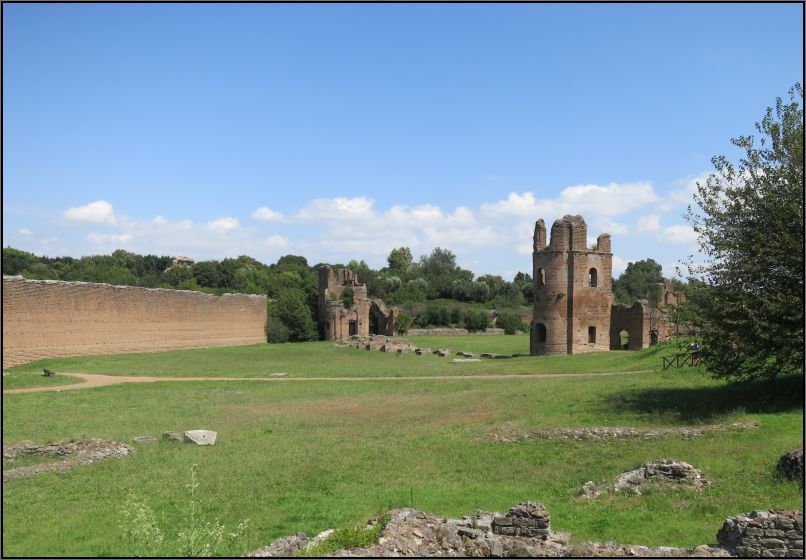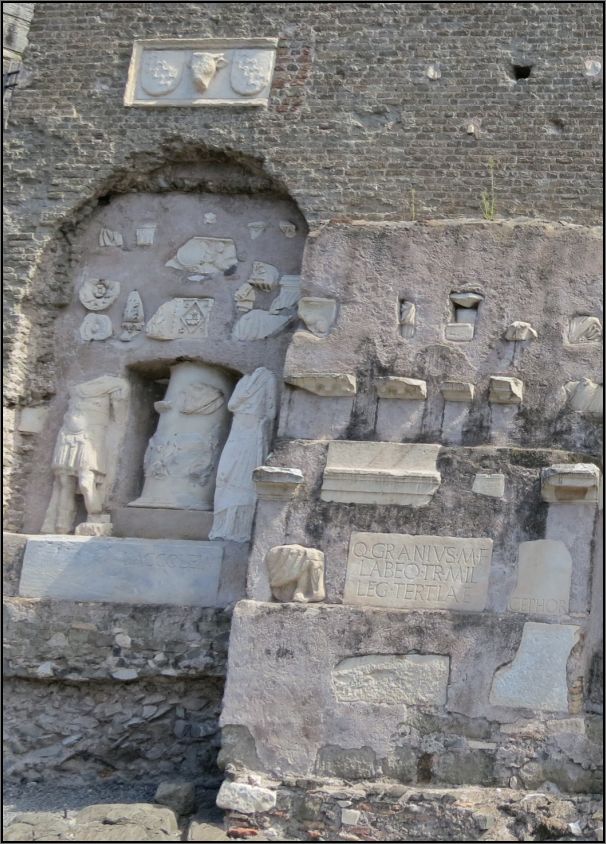The cobblestone street reminded me of the little town of my childhood. The stones were cut in a specific cubical shape, and probably coming from the plenty of the volcanic rocks from the depths of the earth. This time I was walking down the Appian Way, and while I was trying to grasp the meaning of this long road outside of Rome, I was taken by surprise by the little church of Domine Quo Vadis.
The road is famous for its ruins, and for the catacombs along its way, and if you wonder if this is just a tale heard in a movie, then you need to see with your own eyes to match the reality.
I’ve never thought I would be getting to these timeless areas, although part of Rome could speak for itself. Like so many ancient sites, Via Appia Antica has so many old ruins, and they make you think they come from another time. And they do come from another times, giving me wonders, strolling along the unknown way. A new experience, with unexpected feelings, intellectual and spiritual.
Having in mind few stops along the Appian Way I didn’t really know what I am looking for. The road was empty, except the few travelers, like us, lost in their thoughts, and feelings. Stepping outside the modern Rome, we did bump into more ancient ruins. I could tell that each stone from every corner has its own character, and could tell its own story, from wars or from peaceful times, from old, or newer times.

The time is strongly marked in stones, reason this is one of the most famous ancient roads in the world.
Santa Maria in Palmis (or Chiesa del Domine Quo Vadis) is a small church about 800 m from Porta San Sebastiano, built in 1637, in front of an old sanctuary. Accordingly with the apocryphal Acts of Peter, St Peter met the risen Jesus here, while he was fleeing persecution in Rome. It was AD 64, at the time of the Great Fire of Rome, three months after the disastrous fire that destroyed Rome, for which emperor Nero wished to blame the Christians. At the moment when St Peter met Jesus, he asked Jesus: “Quo vadis, Domine?” (Where are you going, Lord?) Jesus answered: “Eo Romam iterum crucifigi” (I am going to Rome to be crucified again). Then, Peter gains the courage to continue his ministry and returns to the city, where he is martyred through crucifixion.
Dated from the 1st century BC, the Tomb of Caecilia is one of the most well known and well-preserved monuments along Via Appia. The monument was built during the Emperor Augustus, to honor Cecilia Metella, the daughter of a Roman Consul. The tomb consists of a cylindrical drum, atop of a square base. The festoons and ox heads were the inspiration for the area to be named Capo Di Bove, meaning head of the bovine, with which the area was known in the Middle Ages. At the top of the monument, medieval battlements can be seen from the time when the tomb was used as a fortress.
In 1303 the tomb was incorporated into the Castrum Caetani, when several constructions were made, including the Caetani Castle, in order to control the pass of the merchants, therefore to charge them taxes.
Some scenes from the Sienkiewicz novel Quo Vadis, or rather from the movie with the same name came to my mind, overwhelming my feelings. The Holly places materialized in front of my eyes once we arrived to San Sebastiano fuori le mura.
This basilica was built over some old catacombs outside the Aurelian Walls. The catacombs are underground burial places, custom inherited from Etruscans, who were burring its dead in excavated underground chambers, or for those who could afford them, in sarcophagi.
After the 2nd century, the catacombs became more popular (especially for Jews and Christians), and more and more were built outside Rome along the main roads, as the Roman law forbade the burials within the city limits. By the end of the sixth century there were over 60 Christian catacombs. Although they were mainly used to bury the dead, the catacombs are known as places where early Christians did hide, and worship at the times they were persecuted.
Beside some other known martyrs, these catacombs are famous for the presence, for some time, of the relics of the Apostles Peter and Paul, reason the original name of the church Basilica Apostolorum (“Basilica of the Apostles”) when was built in the first half of the 4th century. The dedication to Sebastian dates later, in the 9th century.
One of the seven churches of pilgrim of Rome, this basilica is dedicated to St Sebastian, a popular Roman martyr of the 3rd century. A modern world, with deep roots into the history, the church is home to some important relics: the arrow that allegedly killed Sebastiano, together with part of the column to which he was tied during the martyrdom, and a set of marble footprints attributed to Jesus.
Later on, overwhelmed with new thoughts and feelings, we did return to Rome through Porta San Sebastiano, one of the largest and best-preserved gates passing through the Aurelian Walls built in 275 AD as an emergency measure to the barbarian invasion from 270. The gate was known under different names during the time: Porta Appia, Porta Domine quo vadis, and ultimately the current name due to the vicinity to the Basilica of San Sebastiano.
Tip(s) of the day:
- Wear sturdy footwear, as the cobblestone street has its own inconvenience;
- Wear sunscreen and take some water with you, as not much shade along the way during summer time;
- There are several options to visit Via Appia: taking the public transportation, having a guided tour, biking, or simply walking on your own;
- Although Via Appia Antica is so much longer, the first 3 kms outside of Rome are packed with the most important landmarks;
- More information and maps can be found at the visitor centre, but that can be easily missed. Otherwise get your own map, or download the city guide before getting there.
~ visited in August 2014
If you love history and enjoy ancient sites, you might also like:
















Always fun to walk down historical roads and paths, Christie. Sounds like it had an extra special meaning for you. –Curt
LikeLike
Indeed, this kind of cobblestones are specific to Europe I guess, and they always remind me of my childhood town, another ancient place LOL although you know what is funny, it also sits on 7 hills😊 Thank you for reading, Curt!
Christie
LikeLike
Either it was a big town or the hills were small… 🙂
LikeLiked by 1 person
😂😂
LikeLike
This area has such a rich history and amazing buildings to go along with it. Looks like a great walk. I love your pictures especially the arch. Maggie
LikeLiked by 1 person
Thank you Maggie! We had a wonderful time, I wish we could return one day, to walk further more on the Appian Way.
xx
LikeLiked by 1 person
This would be an area I would love to see. So historic and amazing
LikeLiked by 1 person
You will definitely like this area Anita, if you love history. Thank you for reading!
Christie
LikeLike
Never been to this part of Rome before, but what a hidden gem! I appreciate you sharing this with us!
LikeLiked by 1 person
You’re very welcome Rebecca😊
xx
LikeLiked by 1 person
I enjoyed the tour, I noted for my next visit to Italy ! Thank you ! Diana
LikeLiked by 1 person
Thank you! I think you will love this area Diana, it has so much more to offer. Have a wonderful afternoon, xx
LikeLike
This brings back such fond memories of when we visited Rome nearly a decade ago. It’s incredible to think how many people have walked down the Appian Way. There’s so much history here and interesting buildings, structures and ruins to see and learn about.
LikeLiked by 1 person
Glad to bring you back fond memories! So true, there is so much history over there, I wish we could go back one day to explore even more!
Have a lovely afternoon!
xx
LikeLiked by 1 person
sounds like the perfect way to get to Rome!
LikeLiked by 1 person
Right, it seems you know the saying: All Roads Lead to Rome! Appian Way was just one of them🙂
LikeLike
I love those romantic strolls through the cobbled streets of Europe’s older cities as they can provide a bit of that old world charm. Many streets and alleyways in Riga Old Town are paved with cobblestones, too. They’re very much part of the fabric of the historic heart of the city. But while the tourists may admire them, many Latvians are far from keen, especially if you have to struggle to get a pram along it – with your child’s head juddering with every bump. But despite their nuisance, I like the cobbles. They have got character. Thanks for sharing and have a good day. Aiva 🙂 xxx
LikeLiked by 1 person
So true, they can be a real challenge for people using them on a daily basis, I still remember the streets of my childhood🙂 But they have their own charm, especially in the old parts of the old cities.
Thank you for reading, have a beautiful evening🙂
Christie
xx
LikeLiked by 1 person
This was a wonderful walk on the Appian Way, Christie, rich with history. I can only imagine how stimulating it must be to walk these ancient cobblestones. Thanks for the photos and for taking us with you.
LikeLiked by 1 person
Thank you Jet for your kind words, glad you have enjoyed the walk with me🙂
xx
LikeLiked by 1 person